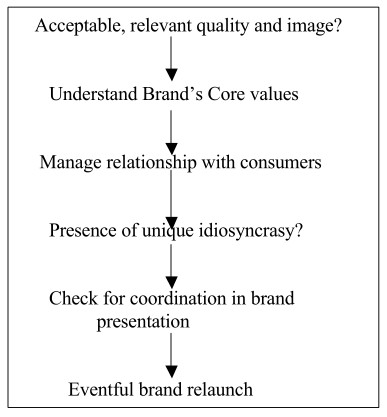When looking to revitalize old brands, one way of progressing is to follow the procedure shown in the figure below.

Stages in Rejuvenating Brands
A considerable amount of data has been collected by the Strategic Planning Institute (Buzzell and Gale 1987), looking at those factors that are strongly related to profitability. One of the key findings was that superior quality goes hand-in-hand with high profitability. But, it is not quality as defined from an internal perspective but from consumers’ perspectives relative to the other brands they use. The slamming of a car door and the resultant ‘thud’, says more too many consumers about a car’s quality than does a brochure full of technical data. The first stage in any revitalization programme should, therefore, investigate what consumers think and feel about the brand. This can be done using a minimum of ten depth interviews, where consumers are presented with the firm’s and competitors’ brands and their perceptions of relative strengths and weaknesses explored. It is particularly important that this be done using qualitative research techniques, since this identifies the attributes that are particularly relevant to consumers. The findings can then be assessed with more confidence by interviewing a much larger sample of consumers with a questionnaire incorporating the attributes found in the depth interviews.
The qualitative market research findings will broadly indicate the physical characteristics of the brand are perceived, such as product formulation, packaging, pricing, availability, etc. They should also provide guidance about emotional aspects of the brand, such as the type of personality that the brand represents. The sorts of issues here may lead to questions such as, is it old fashioned? is it ‘fuzzy’? is it relevant? is it too closely linked to an infrequently undertaken activity? Also by investigating changes in demography, social activities, competitive activity and distribution channels, the marketer should then be able to identify what changes might be needed for the brand’s positioning.
With ideas beginning to evolve about positioning and personality changes, the marketer needs to consider how these would affect what the brand has always stood for. Managers need to be clear about their brand’s core values. Any changes from the first part of the process need to be considered against the brand’s core values. Marlboro stands for dominance, self-esteem, status, self-reliance and freedom. , As it faces an increasingly hostile environment, any changes to make it more acceptable should not go against these core values.
However, as buyers become more’ experienced they will be looking for a ‘husband-wife’ type relationship, where they are treated as an equal, and with some respect. If the marketer has not allowed the brand to recognize the more mature nature of the consumer the wrong type of relationship may impede brand sales.
Brands succeed because people recognize and value their personalities. But, just as people are not perfect, so brands need to have some idiosyncratic element to make them more human. If the brand needs revitalizing, one way to bring it more alive, is to add an idiosyncratic element. Examples of this are the Hathaway man with the eye-patch advertising shirts once a view has been adopted about possible changes, these must be carefully coordinated to ensure that each element of the marketing mix supports the new proposition. What is then required, is a promotional launch that rapidly gets the message across about the rejuvenated brand.

